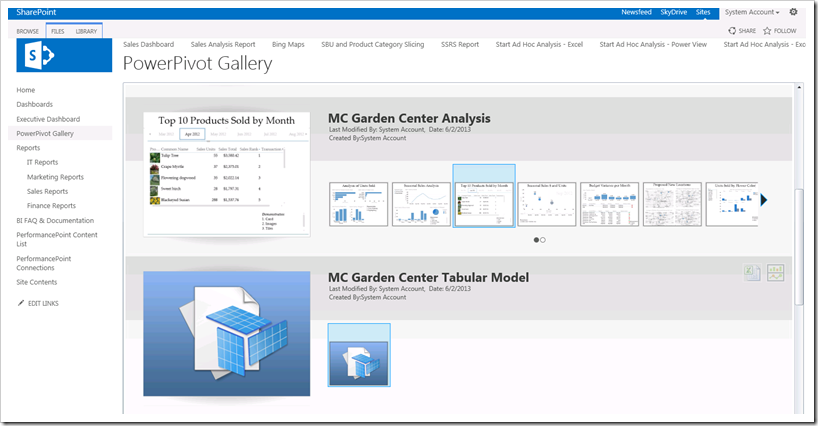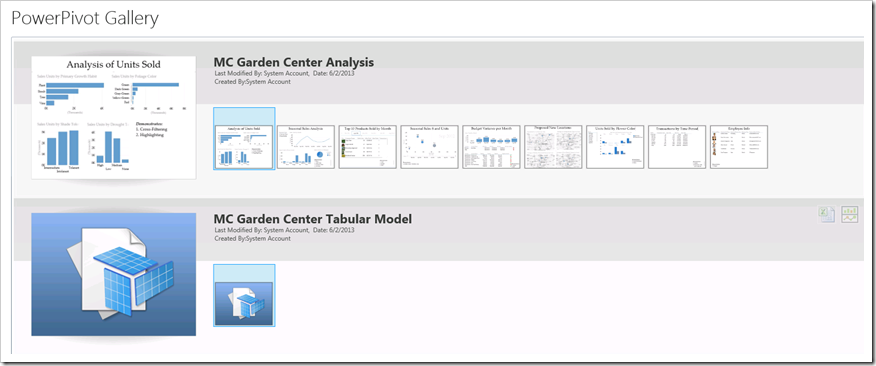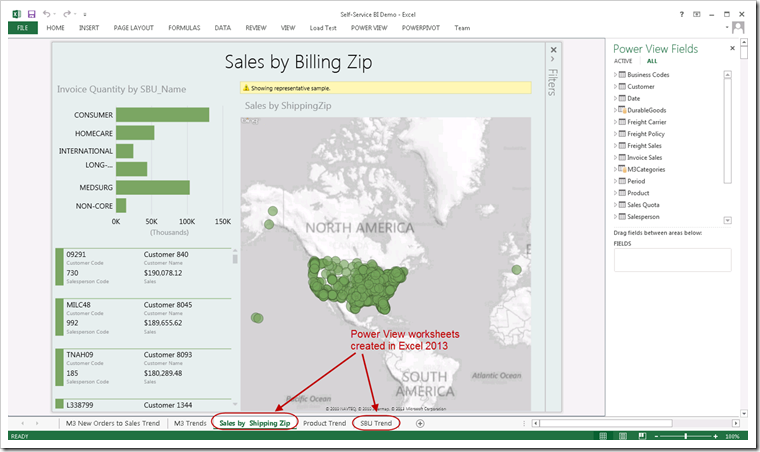Overview: How to structure the URL for displaying a Power View report on a SharePoint 2013 page, including what parameters to pass in the URL. This entry presumes the reader is familiar with SharePoint basics, including how to create a site page.
Ways to Render Power View Reports Within SharePoint
Because of its support for previewing the report via thumbnail images, the PowerPivot Gallery is a very common way of storing & accessing Power View reports:

However, perhaps you really would like to display a Power View report on a SharePoint page, possibly as part of a dashboard that combines various types of reports.
Ways of rendering Power View reports in SharePoint 2013 include:
- Via the PowerPivot Gallery (as shown above)
- Via a regular document library (note: it won’t have the thumbnail previews like the PowerPivot Gallery does due to its integration with Silverlight)
- Within a Page Viewer Web Part
- Within a Silverlight Web Part (note: since word on the street is that Silverlight has a finite lifespan, this might not be your first choice)
- Embedded within a PerformancePoint Dashboard (via the web page report type)
- Within an Excel Web Access Web Part (applicable to Power View reports created with Excel 2013)
Note that even though Power View is part of the Reporting Services family, you cannot use the SQL Server Reporting Services Report Viewer web part – it can only display RDL files (generated from Reporting Services or Report Builder). It cannot currently display RDLX files (generated from Power View for SharePoint).
The remainder if this blog entry focuses on the Page Viewer Web Part.
Steps to Use the Page Viewer Web Part
First, you’ll want to create a Site Page in SharePoint if you don’t have one already. Once you are in Edit mode for your page, go to the Insert ribbon. From there, choose Web Part on the ribbon. Browse through the Media and Content category to find the Page Viewer. Make sure you’ve clicked within the section you want the Power View report to be in, then click Add.

Then you’ll want to click the “open the tool pane” hyperlink to access its properties.

There are four sections of properties – only the first two sections are really important for displaying our Power View report.
Page Viewer Properties

Hint: the only piece that is absolutely positively required is the URL as shown in the above Page Viewer section…but if you skip the rest of the settings, you’ll end up with awfully ugly output that isn’t readable at all:

Since we want it to be pretty, we’ll carry on with the rest of the properties…
Appearance Properties
- Title – Change this from Page Viewer if you intend for the title to be shown (often the report itself will have a title, so often you can omit titling the web part itself too).
- Height – Here’s where you are going to need to experiment somewhat. The “Adjust height to fit zone” default doesn’t really do the trick from what I have seen.
- Width – Chances are you can leave this as-is so it adjusts to fit the zone.
- Chrome State – You’ll want to leave this as normal to ensure the report itself displays.
- Chrome Type – Set this based on how you want to see the page. If you are skipping the Title (i.e., if the report itself has a title), you might set the Chrome Type to have a border only, or perhaps none.

Layout Properties
Nothing required to be changed here.

Advanced Properties
Nothing required to be changed here unless you’d like.

Constructing the URL for Display of the Power View Report
Now let’s take a step back and look at how the URL is constructed. It uses the AdHocReportDesigner.aspx page, as well as several parameters, including:
- RelativeReportURL – Points to the RDLX file
- ViewMode – Presentation or Edit
- ReportSection – Reference to which view will be displayed initially
- Fit – True/False setting which allows for resizing
- PreviewBar – True/False setting which controls if the menu across the top is shown or not
Here’s how the URL can be broken down into its components:

How the Power View Report Looks In the Page Viewer Web Part
How it ends up looking in SharePoint depends a lot on the parameter values you pass in via the URL, as well as the Height property you set in the properties. Note that the pagination controls at the bottom left & bottom right are still active which is nice. This means that even if you set the URL to jump to view 6, for instance, the end user can still paginate through and see all the views (i.e., pages) contained within the single Power View report.
Here’s an example where the Report Section is set to launch page 2 immediately, the View Mode is set to Presentation, and the Preview Bar is set to False within the URL string:

Here’s another example of the same report, except the Preview Bar is set to True within the URL string:

And here’s one more example of the same report, this time with the View Mode set to Edit:

Prerequisites
SharePoint needs to be on-premises (as opposed to SharePoint Online) and configured in “SharePoint View Mode” rather than “Office Web Apps Server Mode.” I’m guessing this is a temporary limitation around OWA support.
The Power View report needs to be created in SharePoint, as opposed to within an Excel 2013 file. This requires the Reporting Services Add-In for SharePoint.
The browser must support the <iframe> element, which basically nests browsing context separately from the entire page. All major modern browsers support iframes.
Finding More Information
Dan English Blog – Presenting Power View Reports to Users
Dan English Blog – URL Actions within Reporting Services Power View (RTM)
Himanshu Gupta Blog – Integrate Power View with SharePoint Using Web Parts
Office - Power View in Excel in SharePoint Server or SharePoint Online in Office 365























